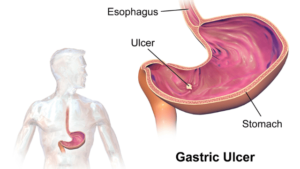Risk Factors for Peptic Ulcer Disease
- Helicobacter pylori infection
- Cigarette smoking
- Chronic Obstructive Pulmonary Disease (COPD)
- NSAID usage (e.g., Paracetamol)
- Alcoholic liver cirrhosis
- Emotional and physical stress
- Zollinger-Ellison Syndrome
- Viral infections
Clinical Presentation
- Epigastric pain
- Burning or aching sensation
- Iron deficiency anemia (along with its symptoms)
- Gastrointestinal hemorrhage
- Ulcer perforation
- Pain that worsens at night (typically between 11 PM and 2 AM)
Additional Manifestations
- Nausea
- Vomiting
- Bloating
- Belching (burping)
- Significant weight loss
- Pain due to perforation, which may be mistaken for cardiac-related pain
Pathophysiology of Peptic Ulcer Disease
Peptic ulcers develop due to an imbalance between protective mechanisms and destructive processes leading to chronic gastritis (except in cases caused by H. pylori infection).
Destructive Processes Include:
- Increased acid secretion due to mucosal atrophy
- Acid from ectopic gastric mucosa (e.g., inside the duodenum, ileal Meckel’s diverticulum, or esophageal ectopic gastric mucosal patch)
Complications of Peptic Ulcer Disease
1. Bleeding
- Most common complication
- Responsible for 25% of ulcer-related deaths
- Often the first indication of an ulcer
2. Perforation
- Accounts for two-thirds of ulcer-related deaths
- Occurs in approximately 5% of patients
3. Obstruction
- Seen in chronic ulcers
- Occurs in about 2% of cases
- Can lead to total obstruction (rare)
- Causes intractable vomiting
Understanding peptic ulcer disease is essential for early diagnosis and effective management. Preventive measures, including reducing NSAID use, quitting smoking, and managing stress, can significantly lower the risk of developing ulcers.

